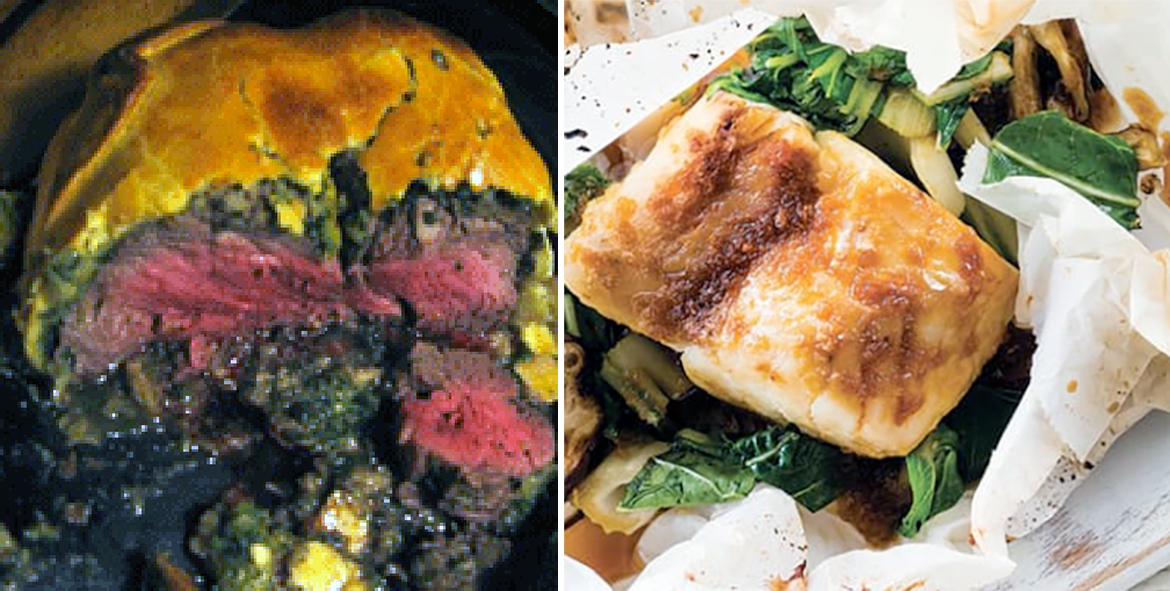FabulousFusionFood's Baking Recipes 16th Page
 A range of baked goods.
A range of baked goods.
Welcome to FabulousFusionFood's Baking Recipes Page — This is a continuation of an entire series of pages that will, I hope, allow my visitors to better navigate this site. As well as displaying recipes by name, country and region of origin I am now planning a whole series of pages where recipes can be located by meal type and main ingredient. This page gives a listing of all the baking recipes added to this site. Baking is defined as a technique for the prolonged cooking of food using dry heat by the action of conduction. Baking is normally done in an oven, but goods may also be baked in hot ashes or on hot stones. Baking differs from Roasting Recipes in that a lower temperature is typically used and the items are cooked for a longer period of time. Baking is a much older process than most people think and foods were probably originally baked in embers or with hot stones (which is how bread may have started). Only later did specialist ovens develop. Though most baked goods tend to be bread or cake-based some other dishes such as pasta dishes and vegetable dishes may also be baked. Stews are often also technically baked in an oven, but are not classed as 'baked goods' in that they are more liquid than solid at the end of the cooking process.
Baking is a method of preparing food that uses dry heat, typically in an oven, but can also be done in hot ashes, or on hot stones. The most common baked item is bread, but many other types of foods can be baked. Heat is gradually transferred "from the surface of cakes, biscuits and cookies, and pieces of bread to their centre, typically conducted at elevated temperatures surpassing 150°C. Dry heat cooking imparts a distinctive richness to foods through the processes of caramelization and surface browning. As heat travels through, it transforms batters and doughs into baked goods and more with a firm dry crust and a softer centre. Baking can be combined with grilling to produce a hybrid barbecue variant by using both methods simultaneously, or one after the other. Baking is related to barbecuing because the concept of the masonry oven is similar to that of a smoke pit.
In addition to bread, baking is used to prepare cakes, pastries, pies, tarts, quiches, biscuits and cookies, scones, crackers, pretzels, and more. These popular items are known collectively as 'baked goods', and are often sold at a bakery, which is a store that carries only baked goods, or at markets, grocery stores, farmers markets or through other venues.
 Beef en croûte (left) and fish en papillote (right).
Beef en croûte (left) and fish en papillote (right).
The alphabetical list of all the baking recipes on this site follows, (limited to 100 recipes per page). There are 2282 recipes in total:
Page 16 of 23
| Passionfruit Crème Patissière Origin: Saint Barthelemy | Pastelitos de yuca con atún (Cassava and Tuna Pies) Origin: Colombia | Penzance Grey Mullet Origin: Cornwall |
| Pastéis de nata (Cream Custards) Origin: Portugal | Pastelón (Sweet Plantain Lasagna) Origin: Puerto Rico | Pepper Pasta Pie Origin: South Africa |
| Pasta Frolla Origin: Italy | Pastelón de Arroz (Cheesy Beef and Rice Casserole) Origin: Dominican Republic | Pepperoni Pizza Origin: Italy |
| Pastai Briwgig a Llugaeorn (Pork Mince and Cranberry Mini Pies) Origin: Welsh | Pastelón de Harina de Maíz (Cornmeal and Beef Casserole) Origin: Dominican Republic | Petits Gâteaux au Sureau (Elderberry Muffins) Origin: Switzerland |
| Pastai Briwgig Eidion a Nionod (Welsh Beef Mince and Onion Pies) Origin: Welsh | Pastelón de Papa (Dominican Cottage Pie) Origin: Dominican Republic | Peynirli Künefe (Turkish Cheesecake) Origin: Turkey |
| Pastai Briwgig Eidion a Nionod (Leek and Caerphilly Cheese Crumble Tart) Origin: Welsh | Pastes hern lagesek (Stargazy Pie) Origin: England | Phaphata (Fried Muffins) Origin: Botswana |
| Pastai Cenin, Panas a Chig Moch (Leek, Parsnip and Bacon Pie) Origin: Welsh | Pastes hern lagesek (Stargazy Pie) Origin: England | Philadelphia-style Butter Cake Origin: American |
| Pastai Cennin (Leek Pasty) Origin: Welsh | Pastiera di Grano (Neapolitan Grain Pie) Origin: Italy | Piña Colada Cupcakes Origin: Britain |
| Pastai Cig Carw (Venison Pie) Origin: Welsh | Pastiera Napoletana (Naples Easter Cakes) Origin: Italy | Pie Crust Origin: Britain |
| Pastai Cig Llo (Veal Pie) Origin: Welsh | Pastilla (Moroccan Meat Pie) Origin: Morocco | Pigeon Pie Origin: British |
| Pastai Cig oen Cymraeg a Phwmpen (Welsh Lamb and Marrow Pie) Origin: Welsh | Pastizzi ta' l-Incov (Anchovy Pastizzi) Origin: Malta | Pigeons in a Hole Origin: British |
| Pastai Cocos (Cockle Pie) Origin: Welsh | Pastizzi tal Pizelli (Pea Pastizzi) Origin: Malta | Pilaf-Stuffed Onions Origin: Middle East |
| Pastai Cocos, Tatws a Chennin (Cockle, Potato and Leek Pie) Origin: Welsh | Pastry Cheesecake Crust Origin: Britain | Pineapple and Carnation Fruit Cake Origin: Britain |
| Pastai Cwnhingen (Rabbit Pie) Origin: Welsh | Pâté breton (Breton Pâté) Origin: France | Pineapple Sage Pound Cake Origin: American |
| Pastai Cymreig Cocos a Chennin (Welsh Cockle and Leek Pie) Origin: Welsh | Pâte Feuilletée (Puff Pastry) Origin: France | Pineappleweed Biscuits Origin: Britain |
| Pastai Draig Gymreig Porc, Cennin a Chwmin (Pork, Leek and Cumin Welsh Dragon Pie) Origin: Welsh | Patellam tyrotaricham ex quocumque salso volueris (A Dish of Cheese and Whichever Salt Fish you Wish) Origin: Roman | Pineappleweed Skolebrød Origin: Britain |
| Pastai Gocos (Cockle Pie) Origin: Welsh | Pâtés à la Goyave (Guava Pasties) Origin: Martinique | Pioniono de Arquipe y Coco (Dulce de Leche and Coconut Roll) Origin: Colombia |
| Pastai Katt (Katt Pie) Origin: Welsh | Patina de Cucurbitis (A Dish of Melon) Origin: Roman | Piparkökur (Icelandic Pepper Biscuits) Origin: Iceland |
| Pastai Mam (Mum's White Pastry) Origin: Welsh | Patina de Pisce Lupo (A Dish of Service-berries) Origin: Roman | Piroshki Origin: Russia |
| Pastai Nadolig Eidion a Chlementin (Christmas Beef and Clementine Pie) Origin: Welsh | Patina Fusilis (A Dish of Cold Asparagus) Origin: Roman | Pisam Farsilem (Pressed Peas) Origin: Roman |
| Pastai Nos Priodas (Wedding Night Pie) Origin: Welsh | Patina Urticarum (A Dish of Stinging Nettles) Origin: Roman | Pistachio and Yoghurt Cake Origin: Britain |
| Pastai Oen Cymreig (Welsh Lamb Pie) Origin: Welsh | Patinam de rosis (A dish of roses) Origin: Roman | Pistolette Roll Origin: American |
| Pastai Penfro (Pembrokeshire Pies) Origin: Welsh | Payne Foundow (Medieval Bread Pudding) Origin: England | Pita Bread Origin: Turkey |
| Pastai Pysgotwr (Fisherman's Pie) Origin: Welsh | Pea Flour Bread Origin: British | Pitcaithly Bannocks Origin: Scotland |
| Pastai Tatws (Potato Pie) Origin: Welsh | Peanut Butter Cheesecake Origin: Britain | Pitta Bread Origin: Middle East |
| Pastai Ystumllwynarth (Oystermouth Pie) Origin: Welsh | Peanut Clusters Origin: Britain | Pizza alla Rustica Origin: Italy |
| Pastai'r Bwthyn (Cottage-style Pie) Origin: Welsh | Peanut Cookies Origin: Britain | Pizza Calabrese (Calabrian Pizza) Origin: Italy |
| Pastei Arennau ac Eidion (Steak and Kidney Pie) Origin: Welsh | Peanut Macaroons Origin: Sudan-a | Pizza Cordon Bleu Origin: France |
| Pastei Bersli (Parsley Pie) Origin: Welsh | Pear and Blackberry Cobbler Origin: Britain | Pizza Napoletana Origin: Italy |
| Pastei'r Porthmon (Drover's Pie) Origin: Welsh | Pease Bannocks Origin: Scotland | Pizza Quattro Stagioni (Four Seasons Pizza) Origin: Italy |
| Pastel de Choclo Origin: Chile | Pennywise Fruit Cake Origin: British | Placenta (Cato's Layered Cheesecake) Origin: Roman |
| Pastel de Jamón (Ham Cakes) Origin: Peru | Penzance Cake Origin: England | Plain Naan Bread Origin: India |
| Pastel de Papas con Tres Quesos (Potato Cake with Three Cheeses) Origin: Peru | Penzance Cake II Origin: England | |
| Pastelillos de Guayaba (Guava Pastries) Origin: Puerto Rico | Penzance Cake III Origin: England |
Page 16 of 23